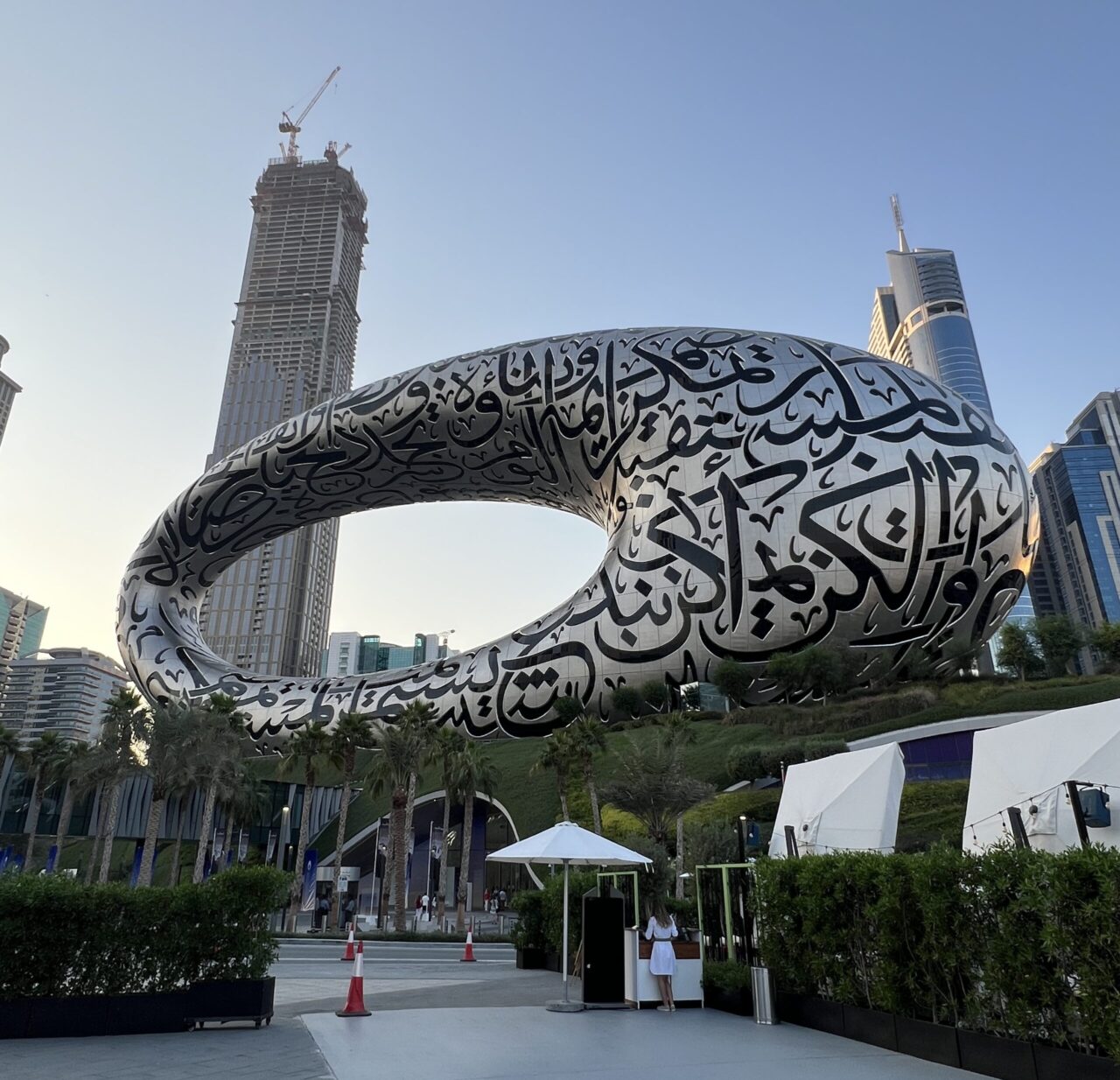Shaping Futures, Building Narratives
Stepping into Dubai’s Museum of the Future feels like walking into a dream. Like going into a surreal, science-fiction-inspired space that’s both strange and deeply captivating. Thanks to its unique architecture – a project by UAE-based architecture firm Killa Design – a gleaming, torus-shaped structure covered in flowing Arabic calligraphy, it commands attention and curiosity. Spending three days there surrounded by thought leaders and changemakers revealed its deeper purpose – it is not just a stunning facade.

The Dubai Future Forum 2024, now in its third edition under the umbrella of the Empowering Generations theme, brought together over 2.500 experts, futurists, policymakers, CEOs, and visionaries from more than 100 countries to confront and solve pressing global challenges. From the conversations I joined, one thing is clear: we cannot predict the future. We must build it, and we can start by shaping the radical solutions and narratives of today.
How to create the future(s)?
The forum highlighted the need to move away from passive future thinking and towards active future creation. Dr. Patrick Noack, Executive Director of Future, Foresight and Imagination at Dubai Future Foundation, provided a compelling perspective during a fireside chat titled ‘Concepts of Time: How Do They Shape Our Future?’ alongside experimental philosopher Jonathan Keats and Anne Beate Hovind, Chair of the Future Library Trust.
“Humans share 60 % of their DNA with a banana and a day fly. But we can make an impact.” Dr. Patrick Noack
While the panelists explored the importance of long-term thinking for a sustainable future, this humorous but profound reminder underscored that while we may share traits with simple organisms, our capacity for meaningful action is unparalleled. Rather than get caught up in forecasting, we need to focus on solving today’s challenges with urgency and creativity.

Discussions also explored protopian thinking, which emphasizes pragmatic, incremental progress over utopian ideals or dystopian fears. This approach was echoed by calls for “radical collaboration,” particularly between the arts and sciences, to address complex global issues like sustainability and social equity.
Cathedral Thinking
One concept that stayed with me was Cathedral Thinking: committing to long-term projects that might outlive us. Just as medieval cathedral builders (Duomo, Milan; Sagrada Familia, Barcelona) began their work knowing they wouldn’t see its completion, we too must invest in solutions for future generations, even if the results – and technological tools – are decades or centuries away.
The Museum of the Future itself is a manifestation of this philosophy. Equally compelling was the forum’s emphasis on space exploration as a strategy for ensuring Earth’s sustainability, a vivid reminder that tackling crises such as climate change requires not only innovative technology but also ambitious imagination.

The Art of Positive Futures
Why are positive futures so hard to imagine, especially in today’s challenging global landscape? A recurring theme at the forum was that negative scenarios come easily –they’re rooted in fears of what might go wrong. Positive futures, by contrast, require us to envision and solve unprecedented problems.
This is where storytelling becomes a powerful tool. It’s not just about inspiring hope; it’s about building actionable blueprints for change. These stories demand imagination, intellectual rigor, and the courage to confront complexity.
The forum emphasised the role of storytelling in fostering political imagination –crafting narratives that galvanize action and invite collaboration. Whether envisioning equitable technologies or tackling climate challenges, stories are the bridge between bold ideas and collective action.

Stories that Shape
As a strategist and storyteller, I left the Dubai Future Forum reminded of the immense power narratives hold. They don’t just entertain or inform – they define how we act. But to wield this power responsibly, we need to move beyond overused platitudes like “The future is now” or “Building a better tomorrow.”
Instead, we should focus on creating spaces or platforms for genuine dialogue. At the forum, I saw the impact of diverse perspectives coming together to challenge assumptions, spark new ideas, and foster collaboration. Discussions explored critical themes such as longevity cities, the transformative role of AI in humanity’s evolution, reimagining childhood in a digital age, and the future of storytelling itself.
Take, for example, the call to prioritise radical solutions made by several key speakers at the event. These included innovations in food security, with alternative proteins and vertical farming emerging as crucial strategies to feed a growing population sustainably. Or the call for more inclusive technologies – systems that are designed to serve the underrepresented, not just the privileged. That’s the kind of storytelling we need – stories that aren’t just about selling an idea but about setting up stronger foundations together.

Looking Ahead
For brands, organisations, and individuals, shaping the future starts today. Ok, I use this narrative once – but the Dubai Future Forum reinforced its truth. While predicting the future is impossible, building it is within our grasp. Radical solutions require impactful storytelling, diverse collaboration, and unwavering dedication to progress. As I flew back to Europe, it felt like returning not just to another time zone but almost to the past – yet inspired and equipped with fresh ideas to drive meaningful change in communication and strategy.
Let’s connect. Whether you’re tackling challenges in storytelling, communication strategy, or envisioning positive futures, I’d love to explore how we can work on impactful solutions together. What ideas or initiatives are inspiring you to think differently about the future? Let’s keep the conversation going.
This article is taken from our Substack newsletter. You can subscribe to it here.